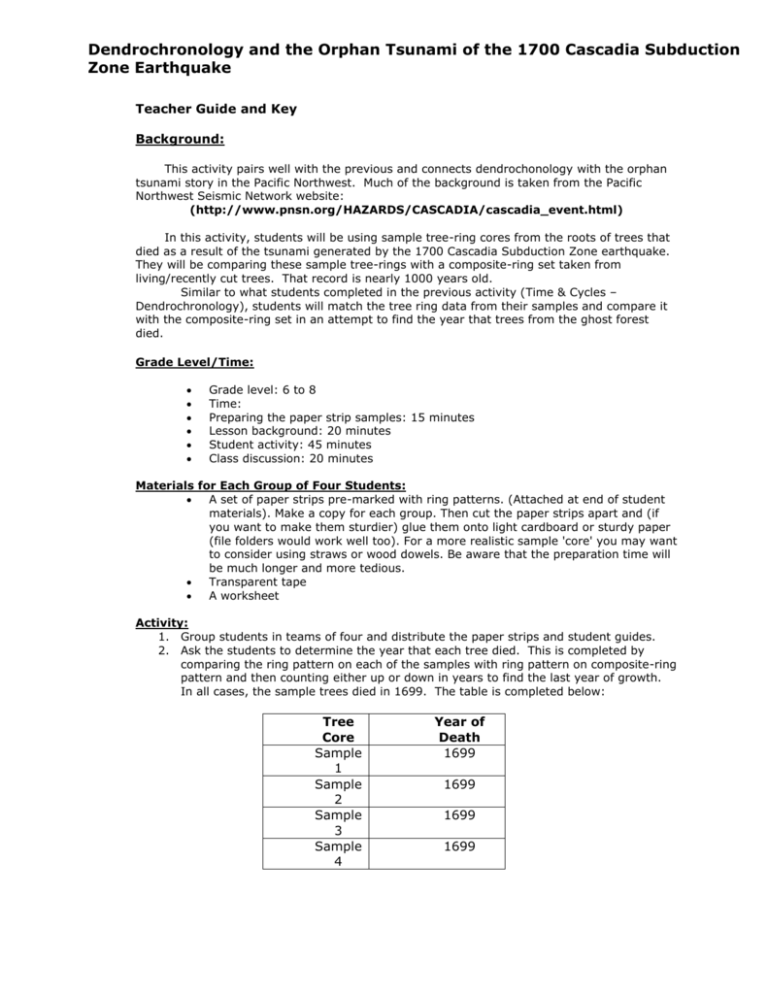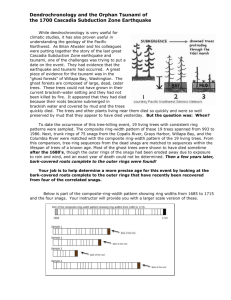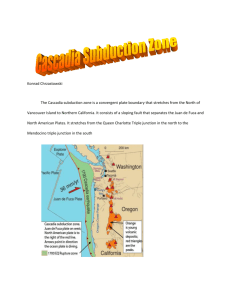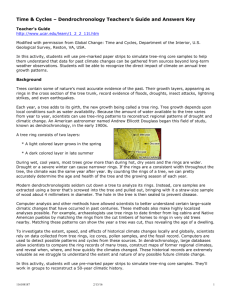Teachers` Guide and Key
advertisement

Dendrochronology and the Orphan Tsunami of the 1700 Cascadia Subduction Zone Earthquake Teacher Guide and Key Background: This activity pairs well with the previous and connects dendrochonology with the orphan tsunami story in the Pacific Northwest. Much of the background is taken from the Pacific Northwest Seismic Network website: (http://www.pnsn.org/HAZARDS/CASCADIA/cascadia_event.html) In this activity, students will be using sample tree-ring cores from the roots of trees that died as a result of the tsunami generated by the 1700 Cascadia Subduction Zone earthquake. They will be comparing these sample tree-rings with a composite-ring set taken from living/recently cut trees. That record is nearly 1000 years old. Similar to what students completed in the previous activity (Time & Cycles – Dendrochronology), students will match the tree ring data from their samples and compare it with the composite-ring set in an attempt to find the year that trees from the ghost forest died. Grade Level/Time: Grade level: 6 to 8 Time: Preparing the paper strip samples: 15 minutes Lesson background: 20 minutes Student activity: 45 minutes Class discussion: 20 minutes Materials for Each Group of Four Students: A set of paper strips pre-marked with ring patterns. (Attached at end of student materials). Make a copy for each group. Then cut the paper strips apart and (if you want to make them sturdier) glue them onto light cardboard or sturdy paper (file folders would work well too). For a more realistic sample 'core' you may want to consider using straws or wood dowels. Be aware that the preparation time will be much longer and more tedious. Transparent tape A worksheet Activity: 1. Group students in teams of four and distribute the paper strips and student guides. 2. Ask the students to determine the year that each tree died. This is completed by comparing the ring pattern on each of the samples with ring pattern on composite-ring pattern and then counting either up or down in years to find the last year of growth. In all cases, the sample trees died in 1699. The table is completed below: Tree Core Sample 1 Sample 2 Sample 3 Sample 4 Year of Death 1699 1699 1699 1699 Analysis: 1. What is a “ghost forest” and how does it form? The ghost forests are composed of large, dead, cedar trees. These trees could not have grown in their current brackish-water setting and they had not been killed by fire. It appeared that they had died because their roots became submerged in brackish water and covered by mud and the trees quickly died. The trees and other plants living near them died so quickly and were so well preserved by mud that they appear to have died yesterday. 2. Where are four places to visit “ghost forests” in the Pacific Northwest? the Copalis River, Grays Harbor, Willapa Bay, and the Columbia River 3. How many years does the entire composite ring-width pattern cover? 1986 – 993 = 993 years Some students will be tempted by: 1715-1685 = 30 years. This is NOT the entire record 4. What year did all of the trees sampled die? Is this the same year as the earthquake? Explain. 1699 No, the earthquake occurred in 1700. With the Japanese oral history there is evidence that the earthquake occurred January 26, 1700. This is during the winter in the northern hemisphere and these trees were not growing during that time, so their last year of growth was 1699 and they were drowned in the winter of 1700, never producing a 1700 year growth ring.











